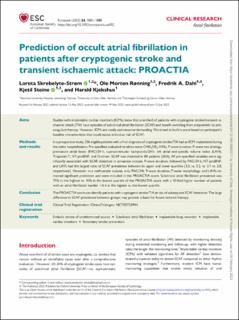| dc.description.abstract | Aims Studies with implantable cardiac monitors (ICMs) show that one-third of patients with cryptogenic stroke/transient ischaemic attack (TIA) have episodes of subclinical atrial fibrillation (SCAF) and benefit switching from antiplatelet- to anticoagulant therapy. However, ICMs are costly and resource demanding. We aimed to build a score based on participant’s baseline characteristics that could assess individual risk of SCAF. Methods and results In a prospective study, 236 eligible patients with a final diagnosis of cryptogenic stroke/TIA had an ICM implantated during the index hospitalization. Pre-specified evaluated variables were: CHA2DS2-VASc, P-wave duration, P-wave morphology, premature atrial beats (PAC)/24 h, supraventricular tachycardia/24 h, left atrial end-systolic volume index (LAVI), Troponin-T, NT-proBNP, and D-dimer. SCAF was detected in 84 patients (36%). All pre-specified variables were significantly associated with SCAF detection in univariate analysis. P-wave duration, followed by PAC/24 h, NT-proBNP, and LAVI, had the largest ratio of SCAF prevalence between its upper and lower quartiles (3.3, vs. 3.2, vs. 3.1 vs. 2.8, respectively). However, in a multivariate analysis, only PAC/24t, P-wave duration, P-wave morphology, and LAVIs remained significant predictors and were included in the PROACTIA score. Subclinical atrial fibrillation prevalence was 75% in the highest vs. 10% in the lowest quartile of the PROACTIA score with a 10-fold higher number of patients with an atrial fibrillation burden >6 h in the highest vs. the lowest quartile. Conclusion The PROACTIA score can identify patients with cryptogenic stroke/TIA at risk of subsequent SCAF detection. The large difference in SCAF prevalence between groups may provide a basis for future tailored therapy. Clinical trial registration Clinical Trial Registration: ClinicalTrials.gov; NCT02725944. | |

